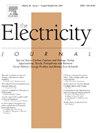“为腐败而生?”私营部门行为者、可再生能源以及墨西哥风电和肯尼亚太阳能发电的腐败风险
IF 2.2
Q1 Social Sciences
引用次数: 0
摘要
未来脱碳的全球能源部门可能需要高达110万亿美元的新投资。由于如此多的资金面临风险,低碳能源系统很可能会吸引并延续腐败。本文旨在概述可再生能源领域的私营部门利益相关者,并研究私营部门气候干预与国际发展之间存在腐败的可能性和实例。本文调查了风能(包括海上和陆上设计的混合)和太阳能光伏板(离网配置)面临的腐败风险和实例。在原始专家访谈和文献分析的基础上,我们探讨了两个国家背景下(墨西哥和肯尼亚)的腐败风险,然后提出了一套解决腐败问题的建议和解决方案,并在结论中提出了对未来研究的建议。本文章由计算机程序翻译,如有差异,请以英文原文为准。
“Made for corruption?” Private sector actors, renewable energy, and corruption risks for wind power in Mexico and solar electricity in Kenya
A future decarbonized global energy sector could require up to $110 trillion in new investment. With so much funding at stake, it is likely that low-carbon energy systems will attract and perpetuate corruption. This paper aims at providing an overview of private-sector stakeholders in the renewable-energy realm and examines possibilities and instances of corruption at the interface between private climate interventions and international development. In this paper, corruption risks and instances facing wind energy (including a mix of offshore and onshore designs) and solar photovoltaic panels (in off-grid configurations) are investigated. Based on original expert interviews and document analysis, we explore corruption risks in two national contexts (Mexico and Kenya) before offering a suite of recommendations and solutions to address corruption, and a conclusion with suggestions for future research.
求助全文
通过发布文献求助,成功后即可免费获取论文全文。
去求助
来源期刊

Electricity Journal
Business, Management and Accounting-Business and International Management
CiteScore
5.80
自引率
0.00%
发文量
95
审稿时长
31 days
期刊介绍:
The Electricity Journal is the leading journal in electric power policy. The journal deals primarily with fuel diversity and the energy mix needed for optimal energy market performance, and therefore covers the full spectrum of energy, from coal, nuclear, natural gas and oil, to renewable energy sources including hydro, solar, geothermal and wind power. Recently, the journal has been publishing in emerging areas including energy storage, microgrid strategies, dynamic pricing, cyber security, climate change, cap and trade, distributed generation, net metering, transmission and generation market dynamics. The Electricity Journal aims to bring together the most thoughtful and influential thinkers globally from across industry, practitioners, government, policymakers and academia. The Editorial Advisory Board is comprised of electric industry thought leaders who have served as regulators, consultants, litigators, and market advocates. Their collective experience helps ensure that the most relevant and thought-provoking issues are presented to our readers, and helps navigate the emerging shape and design of the electricity/energy industry.
 求助内容:
求助内容: 应助结果提醒方式:
应助结果提醒方式:


